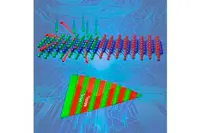 Researchers at the US Department of Energy's Oak Ridge National Laboratory (ORNL) have combined a novel synthesis process with commercial electron-beam lithography techniques to produce arrays of semiconductor junctions in arbitrary patterns within a 1nm-thick semiconductor crystal. This compares to the 10nm-thick crystals currently used in leading edge chips.
Researchers at the US Department of Energy's Oak Ridge National Laboratory (ORNL) have combined a novel synthesis process with commercial electron-beam lithography techniques to produce arrays of semiconductor junctions in arbitrary patterns within a 1nm-thick semiconductor crystal. This compares to the 10nm-thick crystals currently used in leading edge chips.
David Geohegan, co-leader of the study, said: "The development of a scalable, easily implemented process to lithographically pattern and easily form lateral semiconducting heterojunctions within 2D crystals fulfils a critical need for 'building blocks' to enable next-generation ultrathin devices for applications ranging from flexible consumer electronics to solar energy."
The researchers first grew 1nm-thick layers of molybdenum diselenide crystals on substrates and then deposited protective patterns of silicon oxide using standard lithography techniques. They then bombarded the exposed regions of the crystals with a laser-generated beam of sulphur atoms. The researchers say the sulphur atoms replaced the selenium atoms in the crystals to form molybdenum disulphide, which is said to have a nearly identical crystal structure. The two semiconductor crystals formed sharp junctions, the desired building blocks of electronics.
Masoud Mahjouri-Samani, who also co-led the study said: "In the future, it might be possible to produce different patterns on the top and bottom of a sheet. Further complexity could be introduced by layering sheets with different patterns."
Next, the researchers will see if their pulsed laser vaporisation and conversion method will work with atoms other than sulphur and selenium. "We're trying to make more complex systems in a 2D plane because a complete working device needs different semiconductors and metals and insulators," Mahjouri-Samani concluded.
Author
Tom Austin-Morgan
Source: www.newelectronics.co.uk

